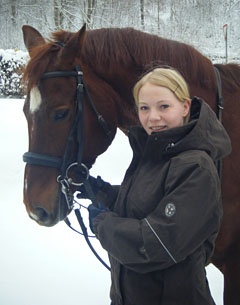
Germany always has many successful dressage riders in the pony, juniors and young riders divisions, consistently winning medals at the European championships. The typical career of a young dressage rider in this country starts with the pony division, followed by the juniors and the young riders, though few are able to move up to Grand Prix. Unfortunately focus is usually on those winning medals at German and European championships while there are equally talented riders who followed a different path to become a Grand Prix rider.
One of them is 17-year old Alexandra Stadelmayer from the south of Germany. She has reached the highest levels earlier than many of her age without consistently taking part in the different age divisions.
When watching her ride one immediately notices that Alexandra represents a remarkable fine style which looks quite differently to what some other riders her age show while performing. Insiders know where it all comes from. Alexandra’s mother Ulrike was among the best dressage riders in Baden-Württemberg competing in the mid 1990s on a Hanoverian called Weyden. This liver chestnut was trained by Alexandra’s famous grandfather Fritz Stahlecker and was sold to Sven Rothenberger before the 1996 Olympics, where he won a silver and bronze medal and went as Dutch team horse.
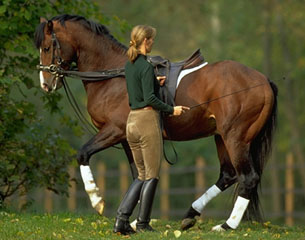 Stahlecker became famous with his quite revolutionary method called “HSH” (hand- saddle-hand). His daughter Ulrike has produced some very good international championship horses like Palladio, Corinth and Bonnard, using the training method of her father.
Stahlecker became famous with his quite revolutionary method called “HSH” (hand- saddle-hand). His daughter Ulrike has produced some very good international championship horses like Palladio, Corinth and Bonnard, using the training method of her father.
So Alexandra was born into a very horsey family: “Horses has always been part of my life as all of my family like riding.” She started riding under the skilled tutelage of her mother and grandpa on very well trained and sensitive horses. Alexandra’s show career began at the age of 6 when she participated in a lead-line class on her mother’s S-level horse Miró in her hometown of Geislingen an der Steige, not far away from Ulm.
Lead-line classes are a popular start for small children in Germany, but Alexandra did not continue like so many others competing on a riding pony. Instead her grandpa gave her an extraordinary Christmas gift in 2003: the then 6-year old dark bay Hanoverian gelding Dix. This talented horse turned out to carry Alexandra from “Reitabzeichen” (riding badge) to Grand Prix within the next six years.
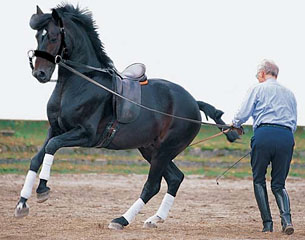 When Stahlecker’s young grandchild got the horse Dix had already been trained by him from the ground in all the difficult movements. Stahlecker’s method, which found more recognition after Weyden became that successful, is quite popular today. Its main principle is to teach the horses the collected movements from the ground at an early age.
When Stahlecker’s young grandchild got the horse Dix had already been trained by him from the ground in all the difficult movements. Stahlecker’s method, which found more recognition after Weyden became that successful, is quite popular today. Its main principle is to teach the horses the collected movements from the ground at an early age.
Stahlecker uses his own gear, a special cavesson with side reins and an overcheck rein which is attached to the nosepiece. The cavesson doesn’t include the typical iron parts on the nose, but instead is very softly padded and comfortable for the horse. The young horses have a snaffle in their mouth, but just to get used to the feeling and not for any other use as the bit is not attached to anything at the beginning. The advantage of this method is that the horses already know all the difficult movements before they are asked to perform them under the saddle much later.
Alexandra worked Dix under the supervision of her mum and her grandpa and formed a strong bond with the gelding, which was bought as a weanling and named after a painting artist like many of Stahlecker’s horses are. Stahlecker's second passion is the art of painting.
“My grandpa bought Dix (by Donnerschlag) because his dam Wievita is a full sister to Weyden and Dix was, like Weyden, bred by Wilhelm and Christiane Köllner from Bodenteich”, Alexandra explained.
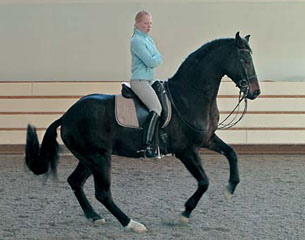 As a young horse Dix was a bit rebellious now and then, but matured into a reliable and totally honest horse. “He’s very cooperative and loves to work without any pressure. Dix reacts to the finest of aids and is completely supple at the shows. His special strength are the canter pirouettes,” Alexandra described her long time partner.
As a young horse Dix was a bit rebellious now and then, but matured into a reliable and totally honest horse. “He’s very cooperative and loves to work without any pressure. Dix reacts to the finest of aids and is completely supple at the shows. His special strength are the canter pirouettes,” Alexandra described her long time partner.
Dix and Alexandra didn’t focus on the typical junior competitions, but started successfully at M- and S-level when she was just 14 years of age. Yet Alexandra has taken part at the Junior Championships of Baden- Württemberg, coming 4th in 2008 while already having won at S-level at 15. In the same year the Hanoverian, for whom juniors level is an easy thing due to the lack of collected movements in which he excels, even placed 2nd in an Intermediaire II competition at CDN Waiblingen.
Alexandra’s grandfather has often said in public that for him dressage is not a sport, but an art. Still his grandchild, who is accompanied to the shows by her parents, loves to compete because “I get to know my standard of riding and new motivation”.
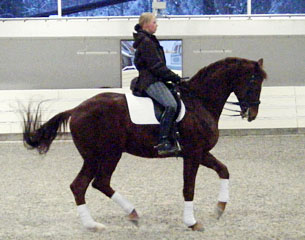 In 2009 Alexandra had the first opportunity to compete against several of Germany’s best Grand Prix riders at Grand Prix level at the renowned national show at Mannheim in May. Of course she still lacked experience at this highest level, but the style in which she competed was impressive and actually rather an art than a sport. In Mannheim Dix was able to qualify for the Grand Prix Spécial, competing against horses like Warum Nicht, Potomac, River of Joy, Le Mont d’Or and Baldessarini.
In 2009 Alexandra had the first opportunity to compete against several of Germany’s best Grand Prix riders at Grand Prix level at the renowned national show at Mannheim in May. Of course she still lacked experience at this highest level, but the style in which she competed was impressive and actually rather an art than a sport. In Mannheim Dix was able to qualify for the Grand Prix Spécial, competing against horses like Warum Nicht, Potomac, River of Joy, Le Mont d’Or and Baldessarini.
Alexandra is currently in her last year of high school and is preparing for her final exams. As time is limited and two young hopefuls are waiting to be taken over from her mum the decision has been made to part with Dix. He was sold in capable hands at the end of 2009.
Since then Alexandra has started to work with the two promising Hanoverians, both bought as 2,5 years old at the Verden stallion market. Liebermann is born in 2003 and now owned by Alexandra. Watteau is two years older, owned by Alexandra’s brother Matthias and previously competed by their mother. According to Alexandra the horse has an outstanding talent for piaffe and passage. Both horses have first been worked from the ground by Alexandra’s mum and are at S- level now.
Though it all sounds very promising Alexandra is cautious about her plans for the 2010 season: “All depends on the horses’ development. We’ll see, but I am planning to start Liebermann at M-/S- level and Watteau probably at Grand Prix this or the next year.”
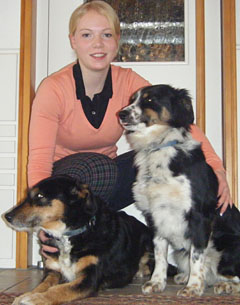 One must assume Alexandra is completely concentrated on her grandfather’s legendary training method, but she likes to look for new ideas everywhere and tries them out at home.
One must assume Alexandra is completely concentrated on her grandfather’s legendary training method, but she likes to look for new ideas everywhere and tries them out at home.
Of course she favours her grandpa’s way of training: “I am thrilled by his training method. All his horses are absolutely okay and have a great ability to collect which enables them to perform great piaffe and passage.” Alexandra does not have an equestrian idol in particular, but likes Anky van Grunsven’s stallion Painted Black: “His ability to extend and his energy are admirable.”
It will be interesting to see where the future will hold for a talent like Alexandra. Like many of her age she’s dreaming of representing her country at an international championships one day.
Profile Alexandra Stadelmayer
- Date of Birth: 3.6.1992
- Place of Birth: Laichingen
- Profession: student
- Hobby: riding, shopping, meeting friends
- Birth sign: Gemini
- Favourite quality: ambitious
- A Personal defect: impatience
- Favourite book: Scott Smith's "The Ruins"
- Favourite film: Law Abiding Citizen
- Favourite actress: Felicitas Woll
- Favourite actor: Jan Josef Liefers
- Style of music: HipHop, R&B
- Favourite singer or band: Jason Derulo, Akon
- Favourite car: Audi A3
- Favourite place you would like to visit:
- Favourite dish: Italian
To find out more about Fritz Stahlecker’s training method visit his informative website
www.hsh-fritz-stahlecker.de
By Silke Rottermann